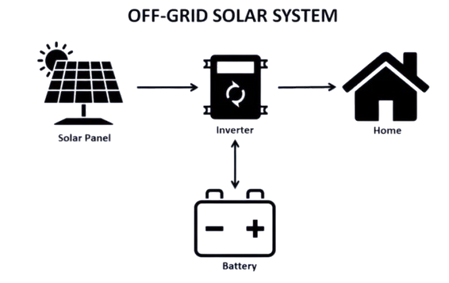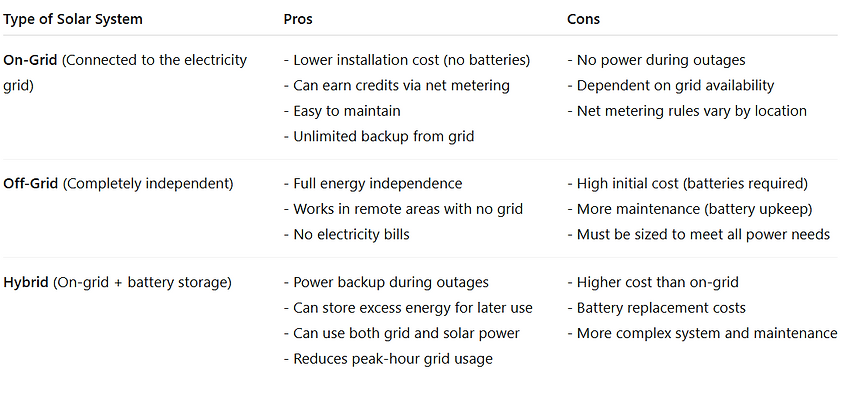Solar
Solutions
At JP Solar, we understand that every energy need is unique, which is why we offer a variety of solar system options to fit different lifestyles and applications. Whether you’re looking to connect to the grid for cost savings, go completely off-grid for energy independence, or choose a hybrid system for the best of both worlds, we have the expertise to design and deliver the right solution for you. Explore our range of on-grid, off-grid, and hybrid solar systems, each tailored to provide reliable, efficient, and sustainable power for your home or business.

On-Grid Solar System
An on-grid solar system connects your solar panels directly to the public electricity grid. It allows you to use solar energy during the day and draw power from the grid when needed, ensuring a continuous electricity supply. Excess solar energy you generate can be fed back into the grid, often earning you credits or savings on your electricity bill. This efficient, cost-effective setup helps you reduce energy costs while supporting a cleaner, greener environment.
Key Parts: (all provided with installation package)
-
Solar Panels & Mounting Structure – Captures sunlight and converts it into direct current (DC) electricity. Mounting structure secures the solar panels on rooftops or ground installations at the correct angle for optimal sun exposure.
-
Inverter – Converts DC electricity from the panels into alternating current (AC) electricity used by your home and synchronizes it to the grid power.
-
Grid Connection – Links your system to the public electricity grid for power exchange.
-
Metering System – Measures the electricity you consume and the excess energy you export back to the grid.
-
Wiring and Electrical Components – Connect all parts safely and efficiently for power flow and system protection.

Photo By JP Solar
Off-Grid System
An off-grid solar system operates independently from the public electricity grid, providing power in remote or off-network locations. It uses solar panels to capture sunlight and convert it into electricity, which is then stored in batteries for use anytime—even when the sun isn’t shining. This self-sufficient setup offers reliable, clean energy without relying on the grid, making it ideal for homes, businesses, or communities seeking energy independence and sustainability.
Key Parts: (all provided with installation package)
-
Solar Panels & Mounting Structure – Captures sunlight and converts it into direct current (DC) electricity. Mounting structure secures the solar panels on rooftops or ground installations at the correct angle for optimal sun exposure.
-
Battery Bank – Stores the electricity generated by the solar panels for use when sunlight isn’t available.
-
Charge Controller – Regulates the voltage and current from the solar panels to safely charge the batteries and prevent overcharging.
-
Inverter – Converts the stored DC electricity from the batteries into alternating current (AC) electricity to power your home.
-
Wiring and Electrical Components – Connect and protect all system parts, ensuring safe and efficient energy flow.

Photo By JP Solar
Hybrid System with a Lithium Ferrophosphate Battery
A hybrid solar system combines the benefits of both on-grid and off-grid setups. It uses solar panels to generate electricity, stores excess energy in batteries, and connects to the public grid. This allows you to use solar power when available, draw from stored battery energy during outages or at night, and still access the grid as a backup. Hybrid systems maximize energy savings, provide power reliability, and offer greater flexibility and independence.
Key Parts: (all provided with installation package)
-
Solar Panels & Mounting Structure – Captures sunlight and converts it into direct current (DC) electricity. Mounting structure secures the solar panels on rooftops or ground installations at the correct angle for optimal sun exposure.
-
Hybrid Inverter – Converts DC to AC power, manages energy flow between solar panels, batteries, and the grid.
-
Battery Bank – Stores excess solar energy for use during night or power outages.
-
Charge Controller – Regulates charging of the batteries to prevent overcharging and extend battery life.
-
Grid Connection – Allows the system to draw electricity from or feed excess power back to the public grid.
-
Wiring and Electrical Components – Connect all system parts safely and efficiently.

Photo By JP Solar
Pros & Cons - On-Grid vs Off-Grid vs Hybrid Solar Systems

Which system is right for you?
-
Choose On-Grid if you want the most cost-effective solution, live in an area with a reliable grid, and want to benefit from net metering.
-
Choose Off-Grid if you live in a remote area without grid access, or want complete independence from utility companies.
-
Choose Hybrid if you want the best of both worlds — lower bills, energy backup during outages, and flexibility for future needs.
At JP Solar, we’ll help you assess your energy needs, location, and budget to design the perfect system for you — whether it’s on-grid, off-grid, or hybrid

